Effect of Elemental Sulfur and Sulfide on the Corrosion Behavior of Cr-Mo Low Alloy Steel for Tubing and Tubular Components in Oil and Gas Industry
Abstract
:1. Introduction
2. Experimental Procedure
2.1. Material and Sample Preparation
2.2. Direct Sulfur/Iron and Sulfide/Iron Reactions Preparation
2.3. Electrochemical Measurements
2.4. Surface Morphology Observation and Corrosion Product Layers Analysis
3. Results and Discussion
3.1. First Series of Experiments; Effect of Sulfide (S2−) on the Corrosion Mechanism of Cr-Mo Low Alloy Steel
3.1.1. Corrosion Behavior of Cr-Mo Low Alloy Steel
3.1.2. Corrosion Rate of Cr-Mo Low Alloy Steel
3.2. Second Series of Experiments: the Effect of Elemental Sulfur (S8) on the Corrosion Mechanism of Cr-Mo Low Alloy Steel
3.2.1. Corrosion Behavior of Cr-Mo Low Alloy Steel
3.2.2. Corrosion Rate of Cr-Mo Low Alloy Steel
3.3. Analysis of Corrosion Product Layers on the Surface of the Alloy
General Comparison of the Corrosion Product Layers in Two Series of Experiments
4. Conclusions
- Corrosion resistance of Cr-Mo alloy in the presence of elemental sulfur is significantly lower than its resistance in the presence of sulfide ions with the same experimental conditions.
- Increasing the pH significantly decreases the corrosion rate of Cr-Mo alloy steel in the presence of elemental sulfur, which is due to the formation of evener and compact corrosion product layers on the alloy surface.
- The effect of immersion time on the corrosion behavior of the alloy is more complicated than the effect of pH. Results suggest that a number of factors such as microstructure, composition and the stability of corrosion product layers and immersion time can increase or decrease the corrosion rate.
- How stable the corrosion product layers are from elemental sulfur corrosion in various aggressive environments needs to be further investigated.
Acknowledgments
Author Contributions
Conflicts of Interest
References
- Fang, H.; Young, D.; Srdjan, N. Elemental sulfur corrosion of mild steel at high concentration of sodium chloride. In Proceedings of the 17th International Corrosion Congress, Las Vegas, NV, USA, 6–10 October 2008; Volume 2592, pp. 1–16. [Google Scholar]
- Bojes, J.; Lerbscher, J.; Wamburi, W.; Dilley, C. Elemental sulfur in 3-phase sour gas systems—Is condensate really your ally? In Proceedings of the Northern Area Western Conference, Calgary, AB, Canada, 15–18 Febuary 2010; pp. 1–22. [Google Scholar]
- Steudel, R. Mechanism for the formation of elemental sulfur from aqueous sulfide in chemical and microbiological desulfurization processes. Ind. Eng. Chem. Res. 1996, 35, 1417–1423. [Google Scholar] [CrossRef]
- Macdonald, D.D.; Roberts, B.; Hyne, J.B. Corrosion of carbon steel by wet elemntal sulfur. Corros. Sci. 1978, 18, 411–425. [Google Scholar] [CrossRef]
- Fang, H.; Brown, B.; Young, D.; Nesic, S. Investigation of elemental sulfur corrosion mechanisms. NACE Int. 2011, 8637, 1–13. [Google Scholar]
- Fang, H. Investigation of Localized Corrosion of Carbon Steel in H2S Environments. Ph.D. Thesis, Ohio University, Athens, OH, USA, 2012. [Google Scholar]
- Petroleum and Natural Gas Industries—Materials for use in H2S—Containing Environments in Oil and Gas Production; NACE International: Houston, TX, USA, 2015.
- ASTM Standard Reference Method for Making Potentiostatic and Potentiodynamic Anodic Polarisation Measurements; ASTM International: West Conshohocken, PA, USA, 1982; pp. 511–521.
- Khaksar, L.; Whelan, G.; Shirokoff, J. Electrochemical and microstructural analysis of FeS films from acidic chemical bath at varying temperatures, pH, and Immersion Time. Int. J. Corros. 2016, 2016, 1025261. [Google Scholar] [CrossRef]
- Saeed Akhtar, M.; Alenad, A.; Azad Malik, M. Synthesis of mackinawite FeS thin films from acidic chemical baths. Mater. Sci. Semicond. Process. 2015, 32, 1–5. [Google Scholar] [CrossRef]
- Butler, E.A.; Peters, D.G.; Swift, E.H. Hydrolysis reactions of thioacetamide in aqueous solutions. Anal. Chem. 1958, 30, 1379–1383. [Google Scholar] [CrossRef]
- Peeters, O.M.; de Ranter, C.J. Pathways in thioacetamide hydrolysis in aqueous acid: Detection by kinetic analysis. J. Chem. Soc. 1974, 1832–1835. [Google Scholar] [CrossRef]
- Dumbrava, A.; Badea, C.; Prodan, G.; Ciupina, V. Synthesis and characterization of cadmium sulfide obtained at room temperature. Chalcogenide Lett. 2010, 7, 111–118. [Google Scholar]
- Gury, F.; Mohamed, B.; Cournil, M. Precipitation dynamics of zinc sulfide multi-scale agglomerates. AIChE J. 2009, 55, 2553–2562. [Google Scholar]
- Bovin, J.; Oliphant, S. Sulfur Corrosion due to Oxygen Ingress; NACE Internationa: Houston, TX, USA, 2011; pp. 1–12. [Google Scholar]
- Enos, D.G.; Scribner, L.L. The Potentiodynamic Polarization Scan; Technical Report 33; Solartron Instruments: Hampshire, UK, 1997; pp. 1–13. [Google Scholar]
- Sun, W.; Nešić, S.; Papavinasam, S. Kinetics of Iron Sulfide and Mixed Iron Sulfide/Carbonate Scale Precipitation in CO2/H2S Corrosion; NACE International: Houston, TX, USA, 2006; pp. 1–26. [Google Scholar]
- Koteeswaran, M. CO2 and H2S Corrosion in Oil Pipelines. Master’s Thesis, University of Stavanger, Stavanger, Norway, 2010. [Google Scholar]
- Rihan, R.O. Electrochemical corrosion cehaviour of x52 and x60 steels in carbon dioxide containing saltwater solution. Mater. Res. 2013, 16, 227–236. [Google Scholar] [CrossRef]
- Sun, W.; Nesic, S. A Mechanistic Model of H2S Corrosion of Mild Steel; NACE International: Houston, TX, USA, 2007; pp. 1–26. [Google Scholar]
- Sun, W. Kinetic of Iron Carbonate and Iron Sulfide Scale Formation in CO2/H2S Corrosion. Ph.D. Thesis, Ohio University, Athens, OH, USA, 2006. [Google Scholar]
- Lee, K.J. A Mechanistic Modeling of CO2 Corrosion of Mild Steel in the Presence of H2S. Ph.D. Thesis, Ohio University, Athens, OH, USA, 2004. [Google Scholar]
- Alabbas, F.M.; Williamson, C.; Bhola, S.M.; Spear, J.R.; Olson, D.L.; Mishra, B.; Kakpovbia, A.E. Microbial corrosion in linepipe steel under the influence of a sulfate-reducing consortium isolated from an oil field. J. Mater. Eng. Perform. 2013, 22, 3517–3529. [Google Scholar] [CrossRef]
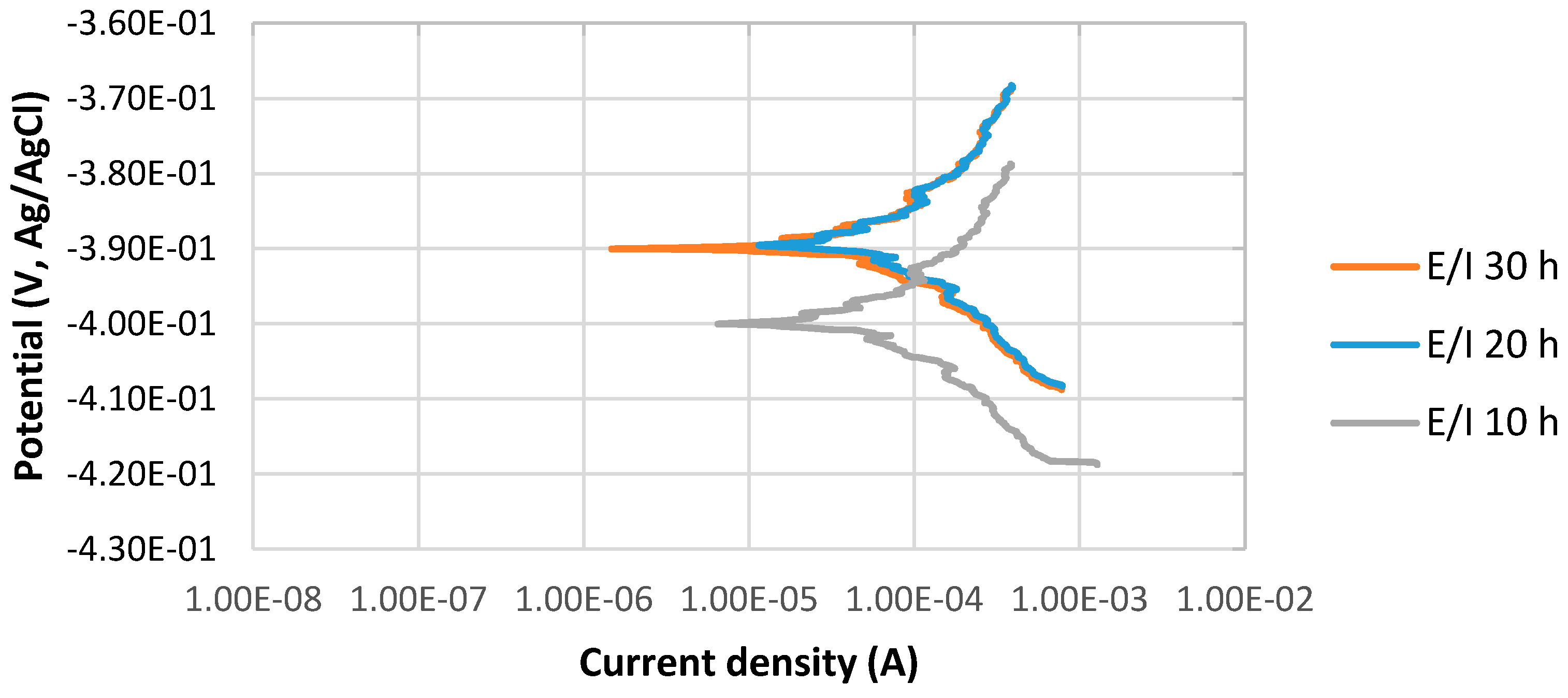
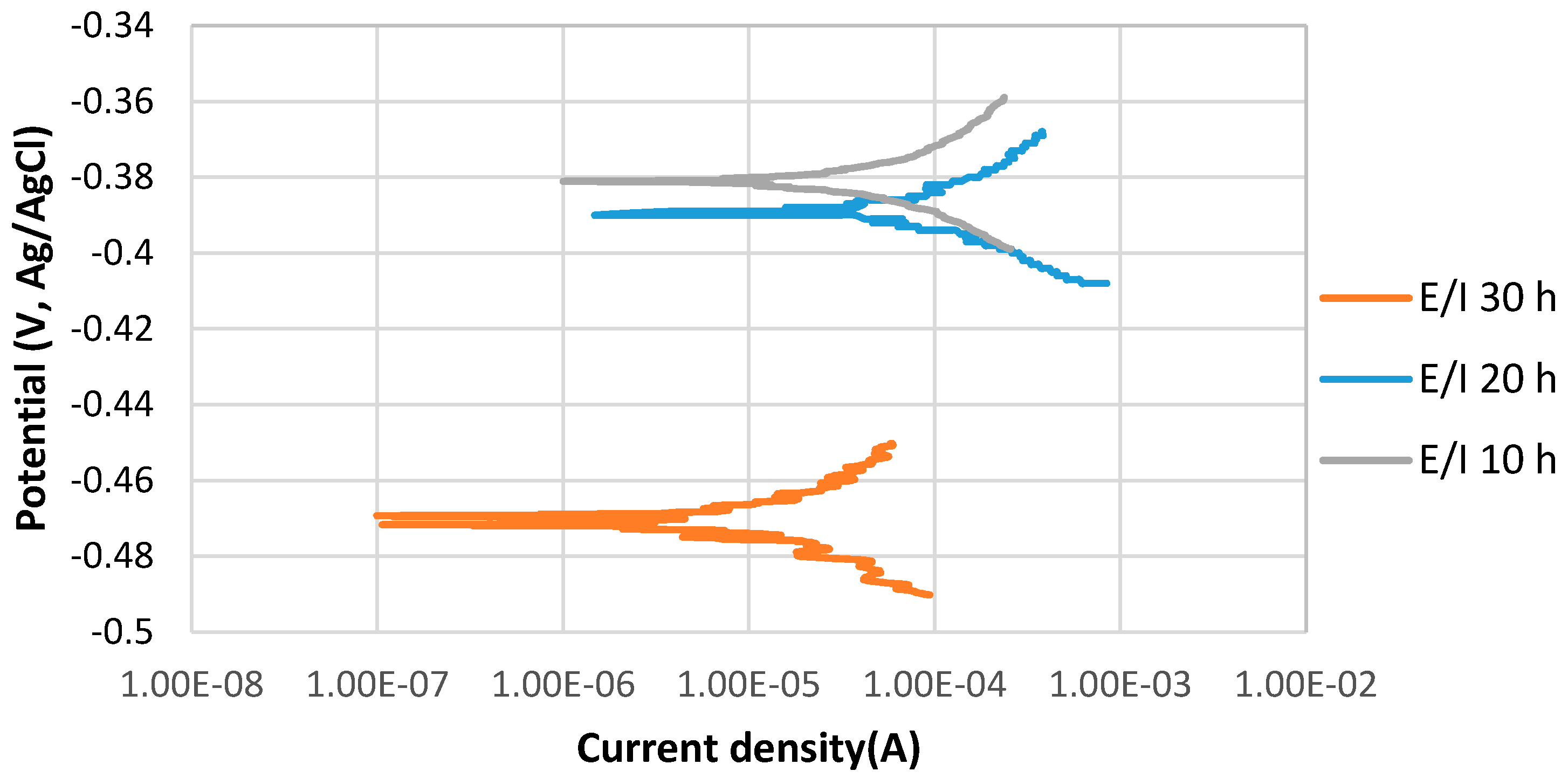
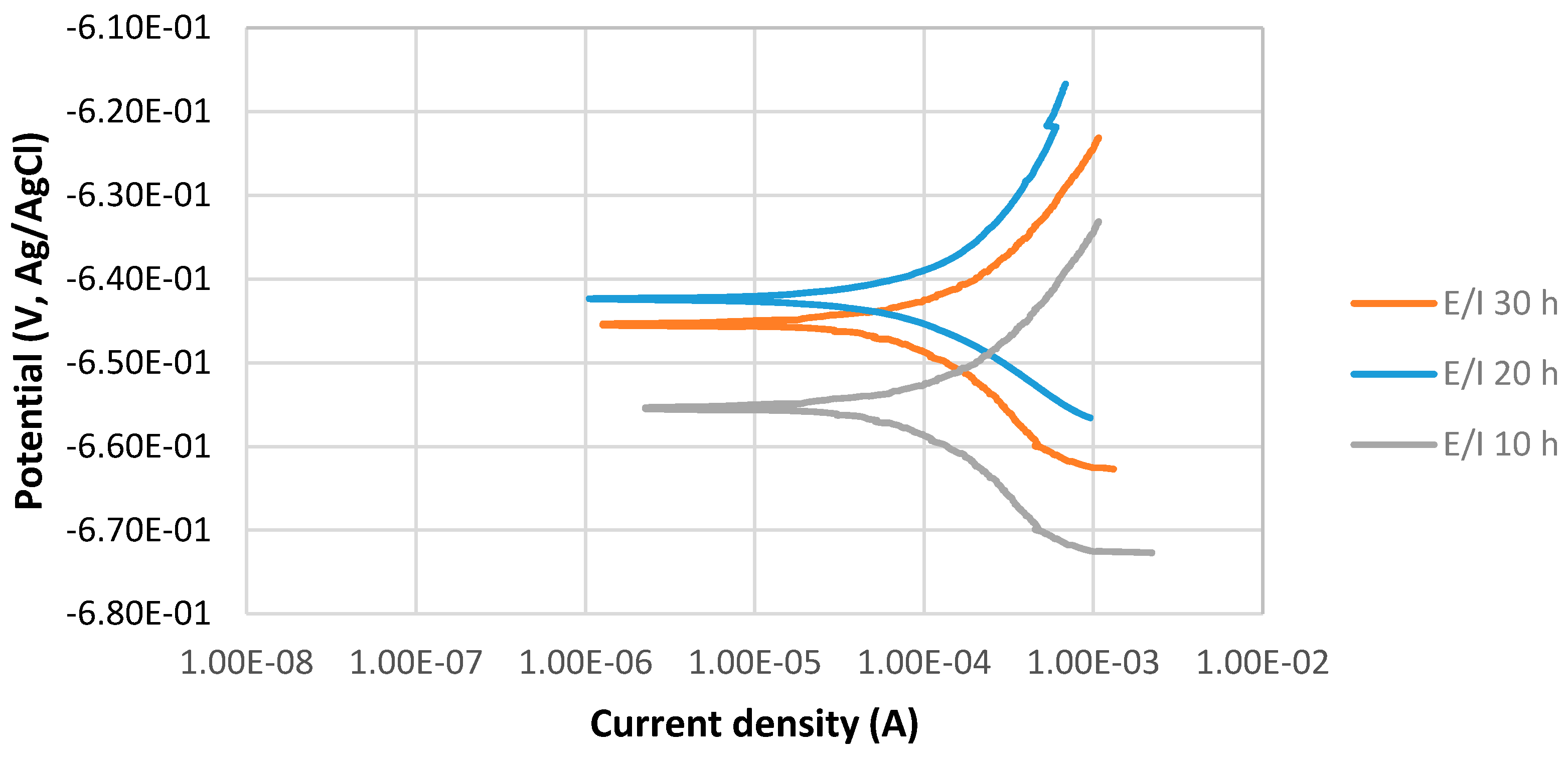
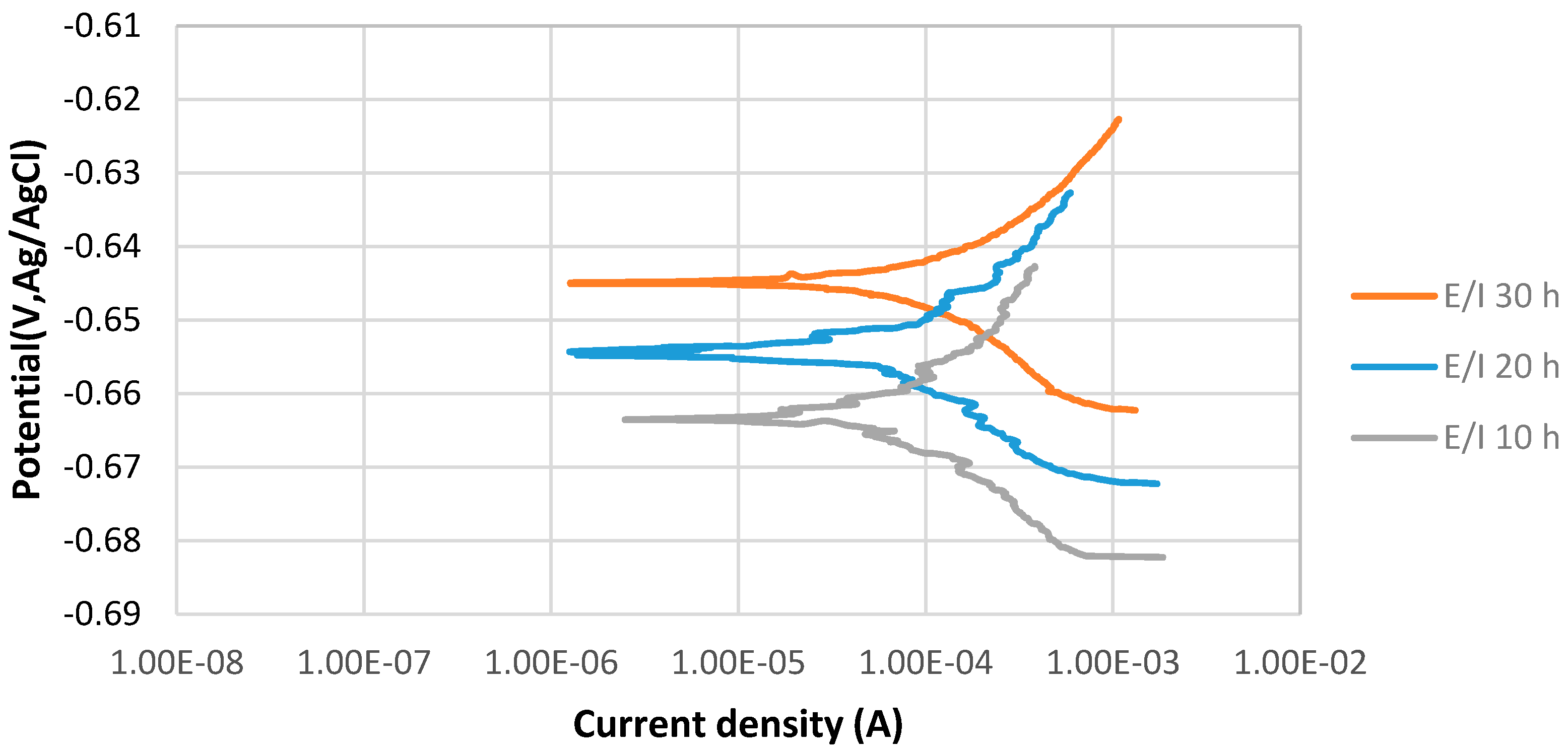
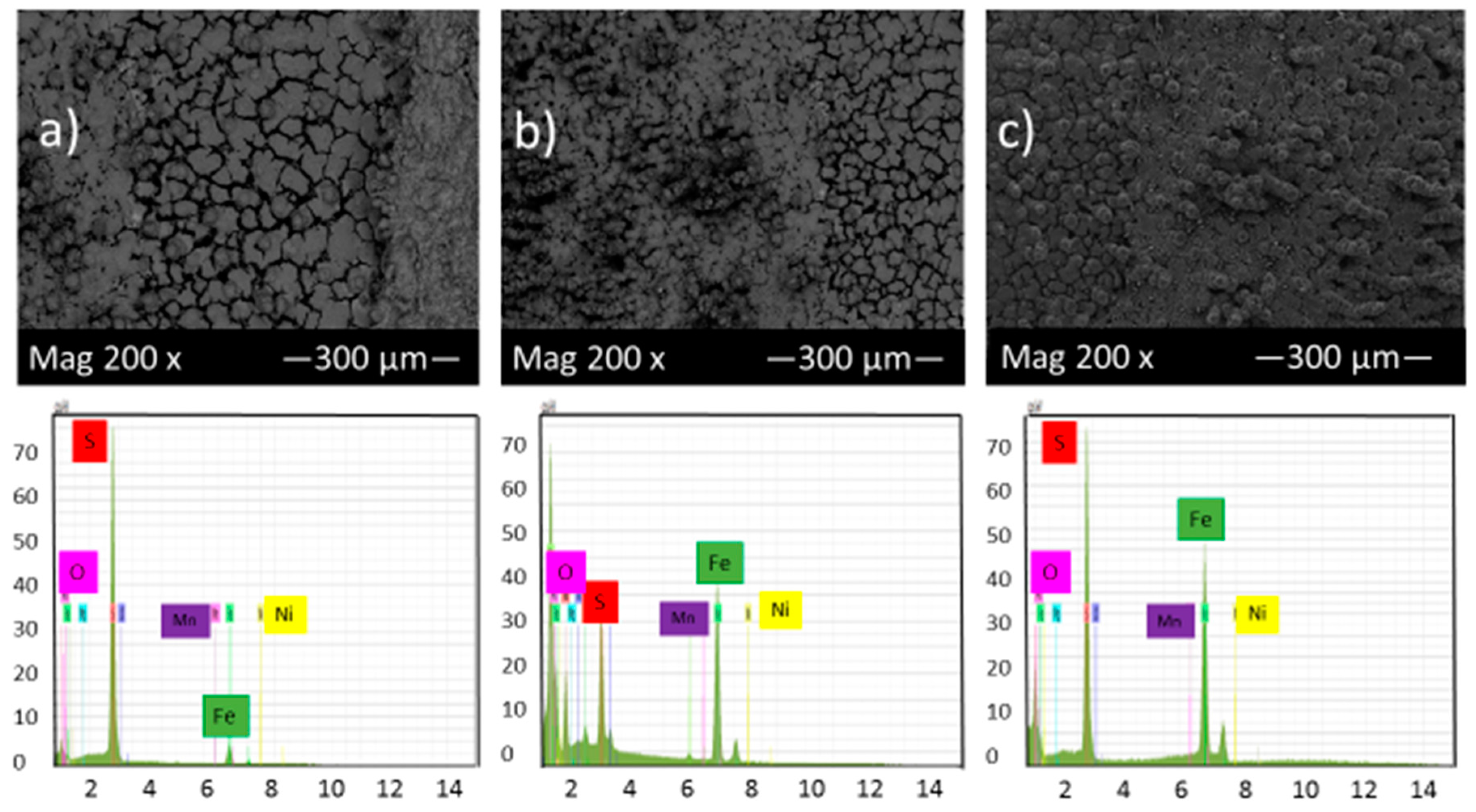
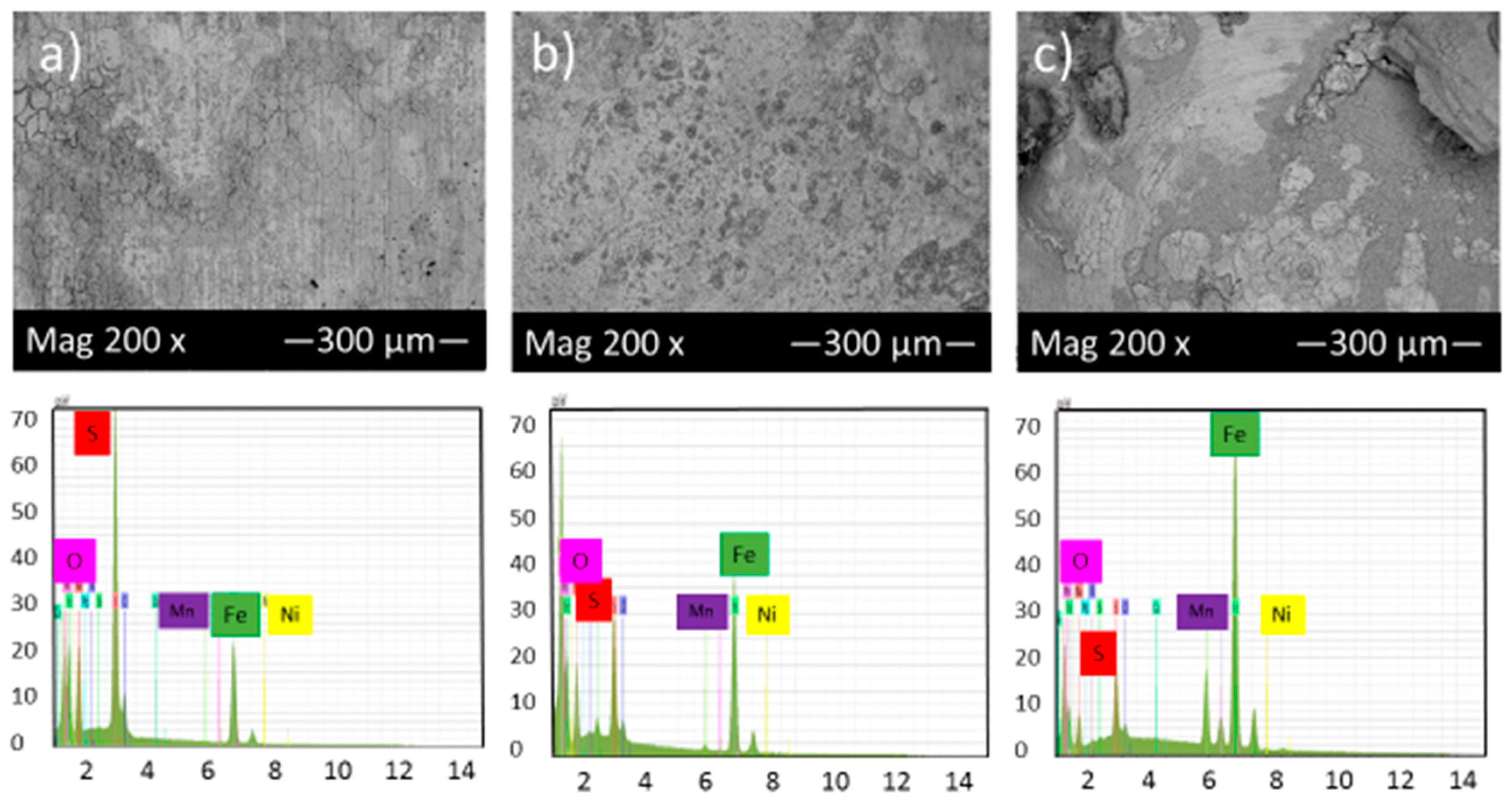
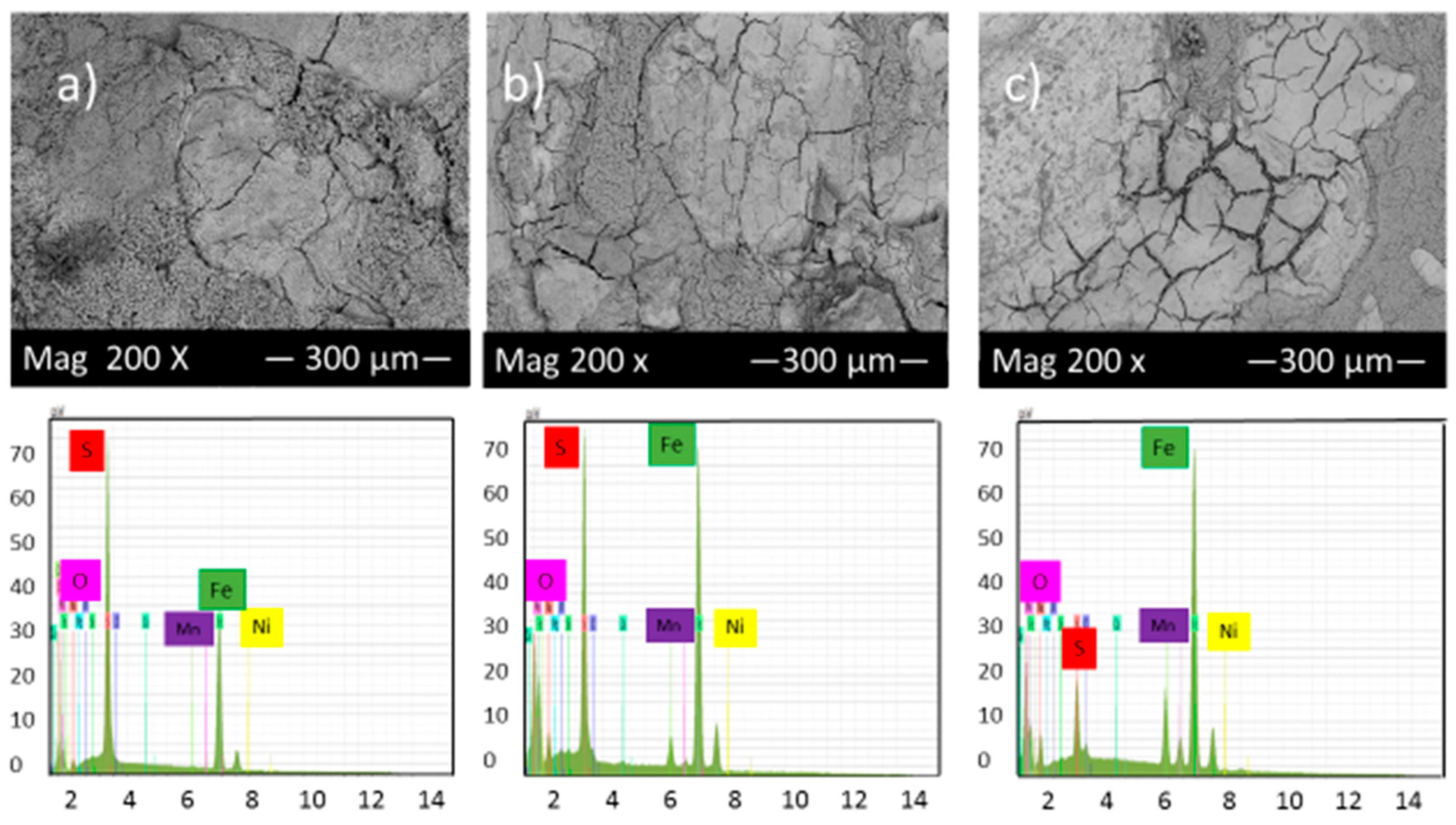
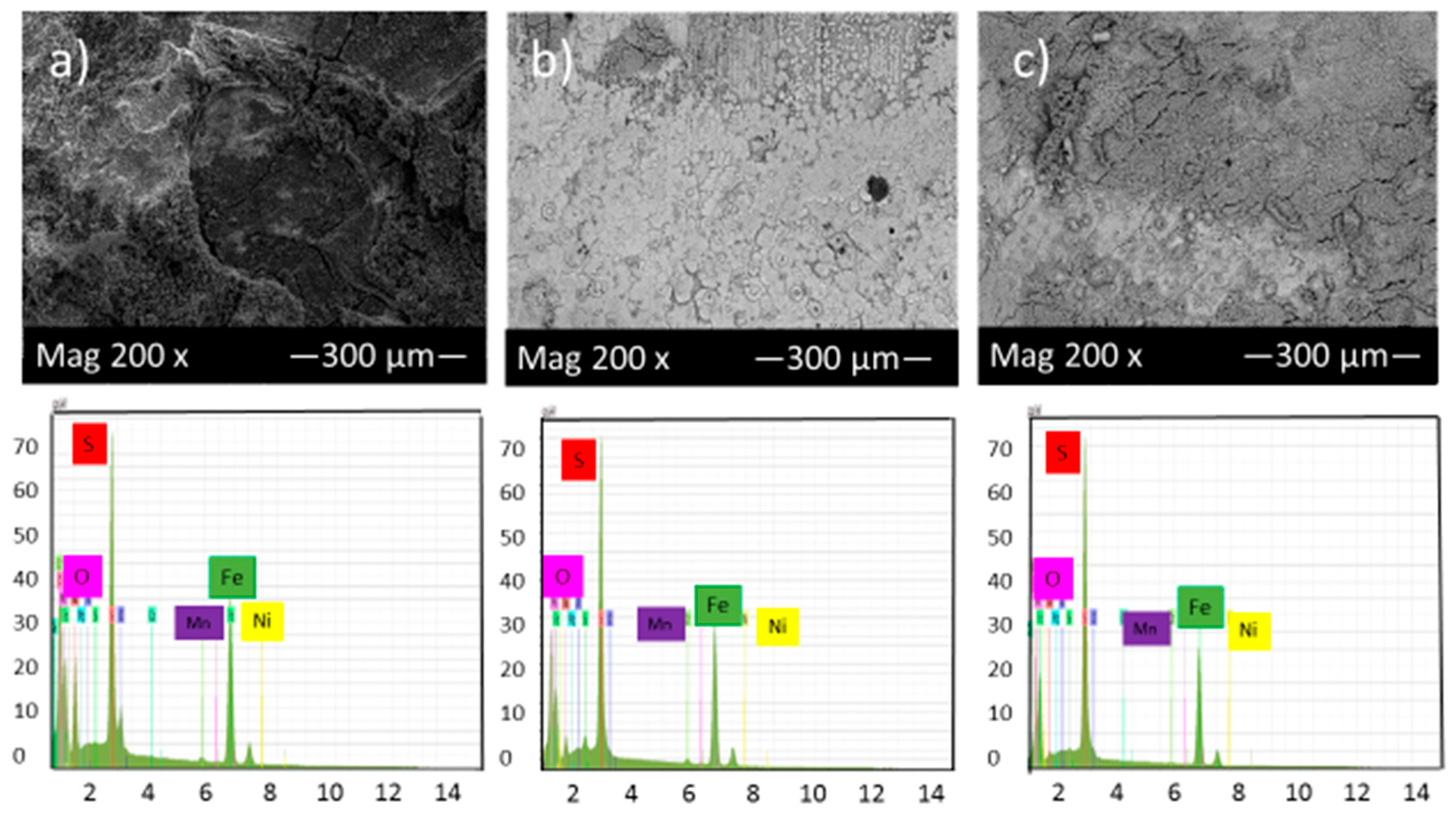
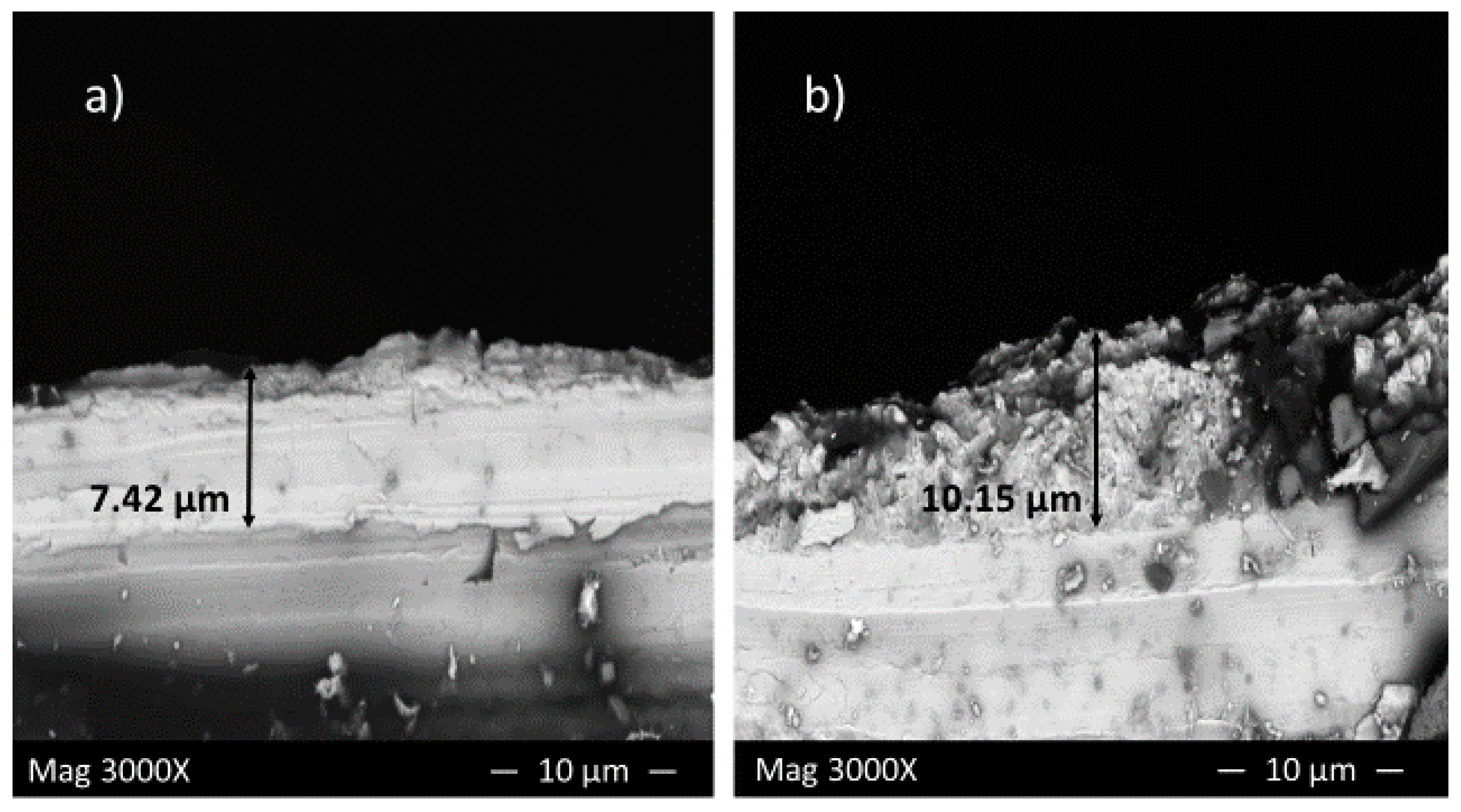
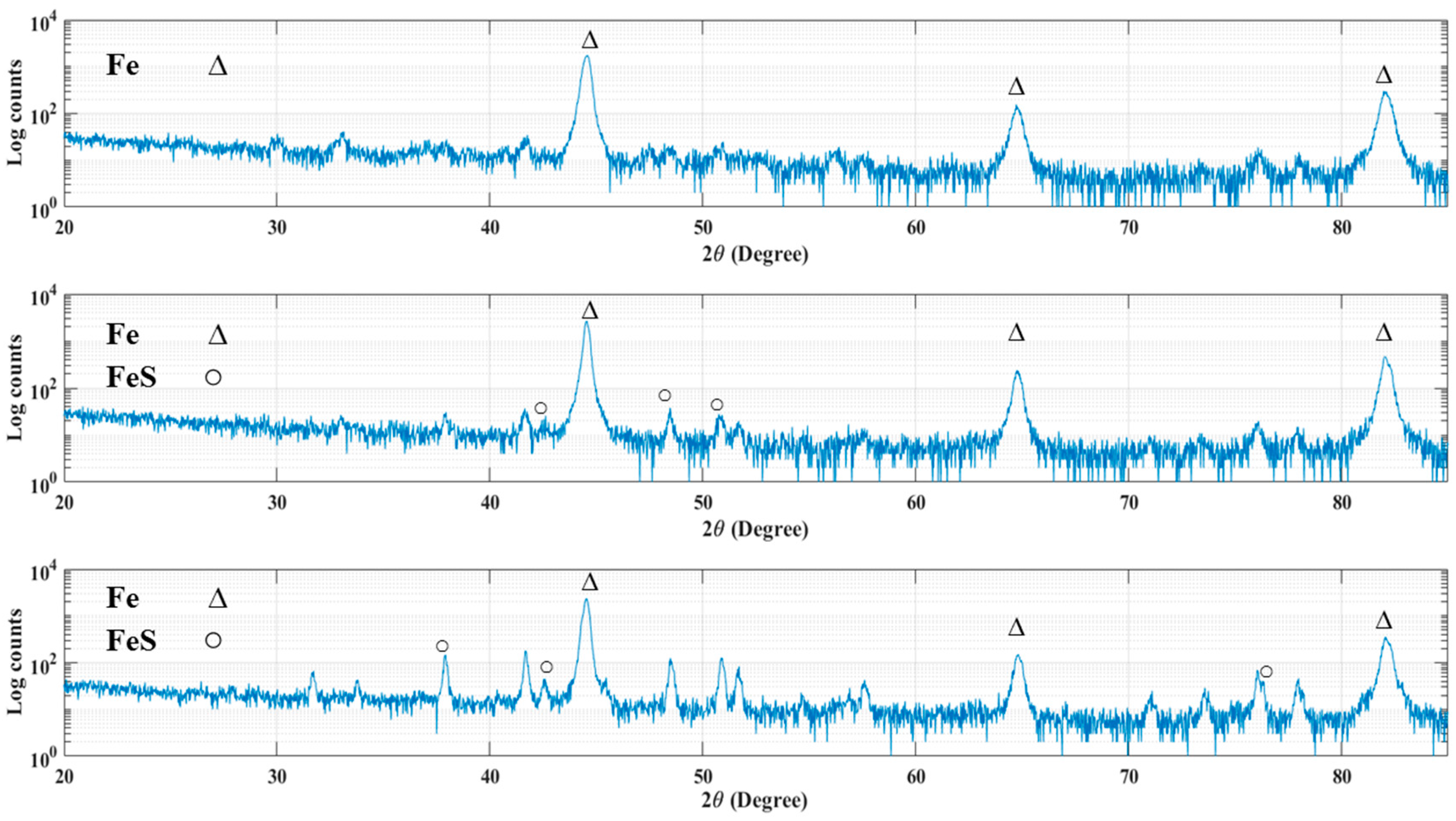
| Condition No. | T (°C) | pH | Immersion Time (h) |
|---|---|---|---|
| 1 | 80 | 2 | 10 |
| 2 | 80 | 2 | 20 |
| 3 | 80 | 2 | 30 |
| 4 | 80 | 5 | 10 |
| 5 | 80 | 5 | 20 |
| 6 | 80 | 5 | 30 |
| Condition No. | T (°C) | PH | Immersion Time (h) |
|---|---|---|---|
| 7 | 80 | 2 | 10 |
| 8 | 80 | 2 | 20 |
| 9 | 80 | 2 | 30 |
| 10 | 80 | 5 | 10 |
| 11 | 80 | 5 | 20 |
| 12 | 80 | 5 | 30 |
| Experiment | (mV·Decade−1) | (mV·Decade−1) |
|---|---|---|
| 1 | 0.022 | 0.019 |
| 2 | 0.029 | 0.020 |
| 3 | 0.020 | 0.019 |
| 4 | 0.034 | 0.023 |
| 5 | 0.021 | 0.018 |
| 6 | 0.028 | 0.020 |
| Experiment | 1 | 2 | 6 | 4 | 5 | 6 |
|---|---|---|---|---|---|---|
| pH | 2 | 2 | 2 | 5 | 5 | 5 |
| Corrosion Rate (CR) (mm/year) | 0.368 | 0.325 | 0.318 | 0.066 | 0.044 | 0.224 |
| Experiment | (mV·Decade−1) | (mV·Decade−1) |
|---|---|---|
| 7 | 0.032 | 0.015 |
| 8 | 0.030 | 0.013 |
| 9 | 0.023 | 0.020 |
| 10 | 0.022 | 0.021 |
| 11 | 0.022 | 0.019 |
| 12 | 0.020 | 0.019 |
| Experiment | 7 | 8 | 9 | 10 | 11 | 12 |
|---|---|---|---|---|---|---|
| pH | 2 | 2 | 2 | 5 | 5 | 5 |
| Corrosion Rate (CR) (mm/year) | 0.615 | 0.605 | 0.595 | 0.381 | 0.367 | 0.318 |
© 2017 by the authors. Licensee MDPI, Basel, Switzerland. This article is an open access article distributed under the terms and conditions of the Creative Commons Attribution (CC BY) license (http://creativecommons.org/licenses/by/4.0/).
Share and Cite
Khaksar, L.; Shirokoff, J. Effect of Elemental Sulfur and Sulfide on the Corrosion Behavior of Cr-Mo Low Alloy Steel for Tubing and Tubular Components in Oil and Gas Industry. Materials 2017, 10, 430. https://doi.org/10.3390/ma10040430
Khaksar L, Shirokoff J. Effect of Elemental Sulfur and Sulfide on the Corrosion Behavior of Cr-Mo Low Alloy Steel for Tubing and Tubular Components in Oil and Gas Industry. Materials. 2017; 10(4):430. https://doi.org/10.3390/ma10040430
Chicago/Turabian StyleKhaksar, Ladan, and John Shirokoff. 2017. "Effect of Elemental Sulfur and Sulfide on the Corrosion Behavior of Cr-Mo Low Alloy Steel for Tubing and Tubular Components in Oil and Gas Industry" Materials 10, no. 4: 430. https://doi.org/10.3390/ma10040430
APA StyleKhaksar, L., & Shirokoff, J. (2017). Effect of Elemental Sulfur and Sulfide on the Corrosion Behavior of Cr-Mo Low Alloy Steel for Tubing and Tubular Components in Oil and Gas Industry. Materials, 10(4), 430. https://doi.org/10.3390/ma10040430






